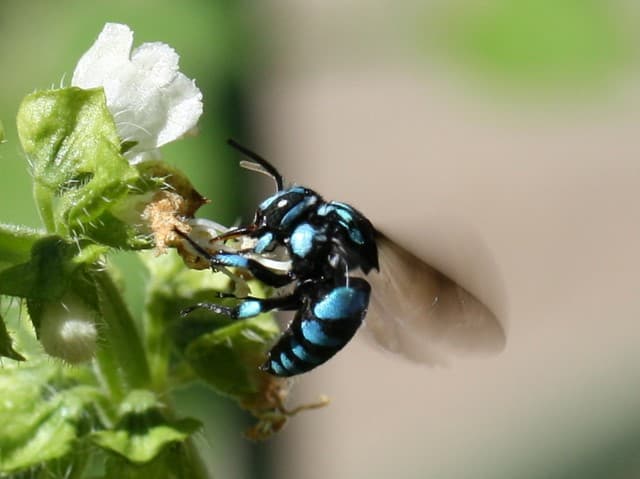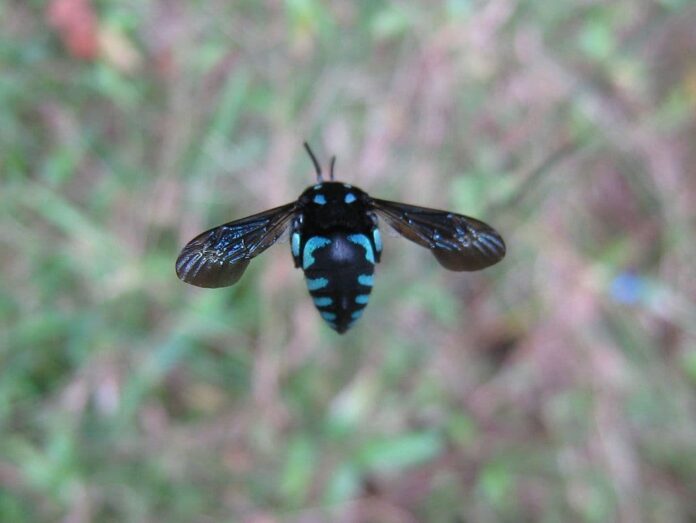We are all familiar with black and yellow bees, but how about the neon cuckoo bee here? Cuckoo bees are different and unique from other members of the bee family, especially in their appearance and habits. Not a lot of people know many things about this interesting bee species. This is why I am here today with some fascinating information about this little insect/parasite for you. Let’s take a look and see if you find them riveting as well.
1Appearance

A neon cuckoo bee has iridescent black and blue body coloration that stands out very clearly in sunlight. The body also has some glittering blue spots, and the transparent wings are light brown with a blue sheen. The appearance and size of a cuckoo bee will depend on its host species. If their host species are bumblebees, they will look very similar to bumblebees. This allows them to take over the nest without causing suspicion. Because of the similarities, sometimes it is very difficult to tell the hosts and the parasites apart. The difference is that cuckoo bees are a bit bigger and tougher than the host which means they are stronger.
In some species, a cuckoo bee also has harder exoskeletons and stronger mandibles as well. At the same time, neon cuckoo bees are very sturdy with their reinforced thorax. In case she gets caught, she can fight her way out safely even if she has to go through multiple stings. Cuckoo bees don’t have much hair on them, and sometimes people confuse these bees with wasps. Because they don’t collect nectar and pollen for their young, they don’t have collecting hairs on their bodies. You can notice a cuckoo bee by the lack of pollen baskets on their legs and less dense hair.
2Behavior

Just like cuckoo birds that get another species to raise their young, cuckoo bees are not so different from them. While most female bees spend their day collecting nectar and pollen for their nests, cuckoo bees are different. Female cuckoo bees are solitary, but a group of females often come together to build their burrow nests near each other. Apart from that, a female cuckoo bee will stay outside the host nest and wait for the female to leave. She then grabs her chance and enters the empty nest and lays her egg there. Cuckoo bees are kleptoparasites (cleptoparasites) which means they lay their egg in the cells of other bee larvae.
A female neon cuckoo bee usually stalks the nest of a blue-banded bee before trying to sneak into it. She does so during the construction of the cell for the nest-owner’s eggs. She will lay an egg in the cell of the host’s eggs before the host mother seals the cell. The egg of the cuckoo bee develops and hatches faster, and the larva eats all the nectar and pollen provisions. When the blue-banded bee larva emerges, there is no food left and it dies. Occasionally, the mother also stays in the host nest and lays many eggs, and sometimes she kills and replaces the queen.
3Feeding & Habitat

These bees visit flowers for nectar since it provides them with the energy they need for daily activities. The females eat pollen to help develop their ovaries, and they feed on a variety of flowers in their habitats. Their most favorite flower is the Brazilian button flower, so they are often found on those flowers.
This bee species live in forests, gardens, heaths, urban areas, and woodlands throughout most of Australia except Tasmania. You can also find them in some parts of New Guinea and Southeast Asia although not so common. Despite being a parasite, their population is also being threatened by the loss of host nesting sites. This is a result of invasive plants, native vegetation clearance, and pesticides.
Related Post: Things You Don’t Know About Tongue-Eating Louse




